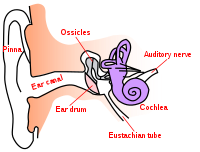
Adenomatous neuroendocrine tumors of the middle ear (MEANTs) with local invasion and lymph nodes metastasis: A brief report of a rare neoplasm
Sign Up to like & getrecommendations! Published in 2020 at "Diagnostic Cytopathology"
DOI: 10.1002/dc.24640
Abstract: Adenomatous neuroendocrine tumors of the middle ear (MEANTs) are very rare neoplasms which are composed of both epithelial and neuroendocrine components. They have mostly bland histology and indolent biological behavior, yet they may recur and… read more here.
Keywords: adenomatous neuroendocrine; invasion; ear meants; neuroendocrine tumors ... See more keywords

Middle ear adenoma: Cytohistologic features and differential diagnosis
Sign Up to like & getrecommendations! Published in 2023 at "Diagnostic Cytopathology"
DOI: 10.1002/dc.25103
Abstract: Middle ear adenomas are rare, low grade glandular neoplasms with epithelial and neuroendocrine components and with varying patterns of differentiation. Due to the rarity of this tumor, there is a dearth of publications detailing the… read more here.
Keywords: cytohistologic features; adenoma cytohistologic; middle ear; ear adenoma ... See more keywords

Immunohistochemical localization of d‐β‐aspartic acid in congenital and acquired middle ear cholesteatoma
Sign Up to like & getrecommendations! Published in 2022 at "Laryngoscope Investigative Otolaryngology"
DOI: 10.1002/lio2.856
Abstract: Middle ear cholesteatoma is characterized by abnormal growth of the keratinizing squamous epithelium of the temporal bone. d‐β‐aspartic acid is the major isomer of d‐aspartic acid found in elderly tissue. We assessed the immunoreactivity to… read more here.
Keywords: acid congenital; middle ear; congenital acquired; ear cholesteatoma ... See more keywords

Validation of a three‐dimensional printed pediatric middle ear model for endoscopic surgery training
Sign Up to like & getrecommendations! Published in 2022 at "Laryngoscope Investigative Otolaryngology"
DOI: 10.1002/lio2.945
Abstract: The purpose of this study is to assess the anatomical appropriateness of a three‐dimensional (3D) printed pediatric middle ear model with a replaceable middle ear unit as an endoscopic ear surgery (EES) simulator. read more here.
Keywords: printed pediatric; middle ear; ear model; dimensional printed ... See more keywords

[Seasonal differences of tympanogram and middle ear findings in children. German version].
Sign Up to like & getrecommendations! Published in 2017 at "HNO"
DOI: 10.1007/s00106-016-0287-7
Abstract: BACKGROUND It is a known fact that bacterial or viral acute otitis media occurs more frequently in the winter months. Only a few older studies on seasonal differences in middle ear findings are available. These… read more here.
Keywords: findings children; ear findings; seasonal differences; middle ear ... See more keywords

[Use of the Carina active middle ear implant in otosclerosis patients].
Sign Up to like & getrecommendations! Published in 2021 at "HNO"
DOI: 10.1007/s00106-020-00984-0
Abstract: Patients with otosclerosis can suffer from different grades of combined hearing loss. In addition to surgery (stapedectomy), conventional hearing aids can be used in the treatment of otosclerosis. In cases of severe conductive components in… read more here.
Keywords: middle ear; hearing loss; otosclerosis; otosclerosis patients ... See more keywords

[Coupling of active middle ear implants-biomechanical aspects].
Sign Up to like & getrecommendations! Published in 2021 at "HNO"
DOI: 10.1007/s00106-021-00994-6
Abstract: Active middle ear implants or implantable hearing aids are used to treat sensorineural or combined hearing loss. Their coupling to the middle ear structures has a large impact on the success of rehabilitation. Practical issues such… read more here.
Keywords: ear implants; coupling active; active middle; ear ... See more keywords

It is prudent to consider use of endoscopic tympanoplasty to treat complicated middle-ear disease
Sign Up to like & getrecommendations! Published in 2017 at "European Archives of Oto-Rhino-Laryngology"
DOI: 10.1007/s00405-017-4624-6
Abstract: We reviewed the paper entitled ‘‘Comparison of endoscopic and microscopic tympanoplasty’’ by Kuo et al. [1]. This is an excellent work, in which the authors compared the healing outcomes and hearing improvements between patients treated… read more here.
Keywords: middle ear; microscopic tympanoplasty; endoscopic; endoscopic tympanoplasty ... See more keywords

A new theory interprets the development of a retraction pocket as a natural self-healing process
Sign Up to like & getrecommendations! Published in 2018 at "European Archives of Oto-Rhino-Laryngology"
DOI: 10.1007/s00405-018-5246-3
Abstract: PurposeThe thesis that cholesteatoma evolves from a retraction pocket is widely accepted today. Yet, its prime etiology, the question of what triggers the invagination of healthy skin, still remains unclear despite centuries of investigations into… read more here.
Keywords: retraction; cholesteatoma; middle ear; self healing ... See more keywords

Lasers in endoscopic middle ear surgery: where do we stand today?
Sign Up to like & getrecommendations! Published in 2021 at "European Archives of Oto-Rhino-Laryngology"
DOI: 10.1007/s00405-021-06807-4
Abstract: To provide an overview of the current status regarding the parallel use of the endoscope and the laser in middle ear surgery. Comprehensive Pubmed search from 1975 to 2020 including clinical articles, of any type,… read more here.
Keywords: surgery; laser; ear surgery; middle ear ... See more keywords

How flexibility and eardrum cone shape affect sound conduction in single-ossicle ears: a dynamic model study of the chicken middle ear
Sign Up to like & getrecommendations! Published in 2019 at "Biomechanics and Modeling in Mechanobiology"
DOI: 10.1007/s10237-019-01207-4
Abstract: It is believed that non-mammals have poor hearing at high frequencies because the sound-conduction performance of their single-ossicle middle ears declines above a certain frequency. To better understand this behavior, a dynamic three-dimensional finite-element model… read more here.
Keywords: eardrum; sound conduction; cone shape; middle ear ... See more keywords